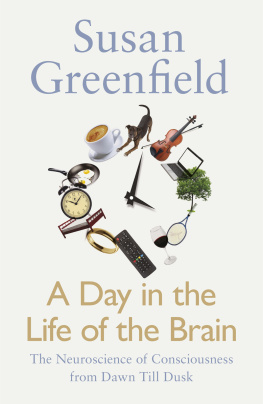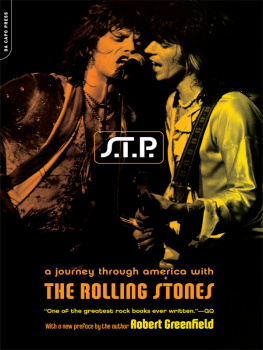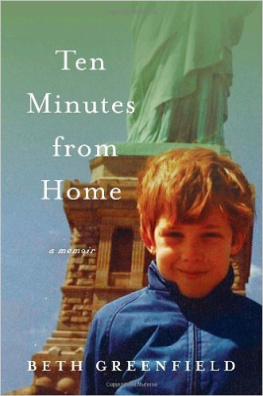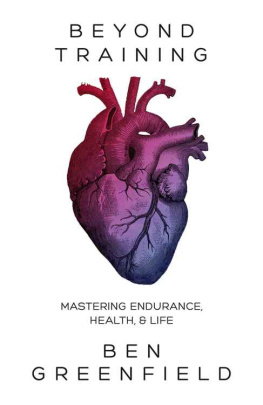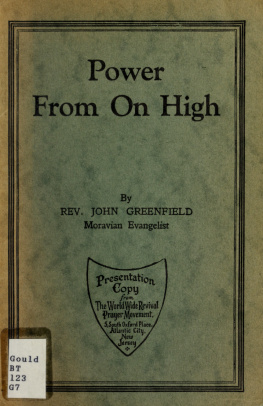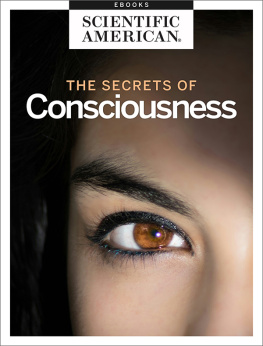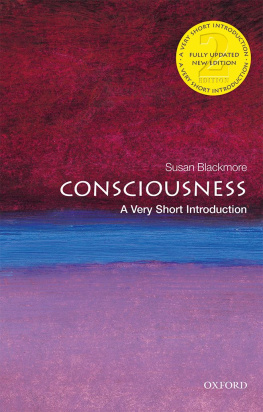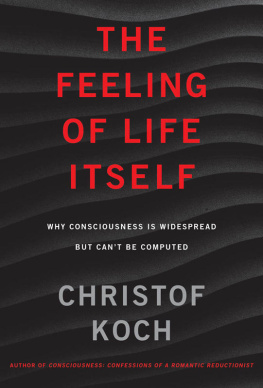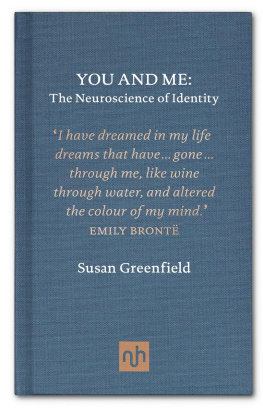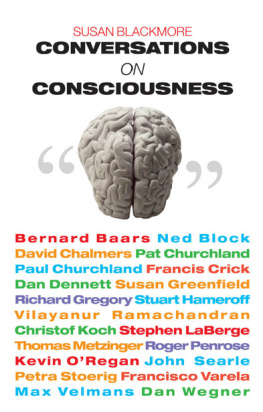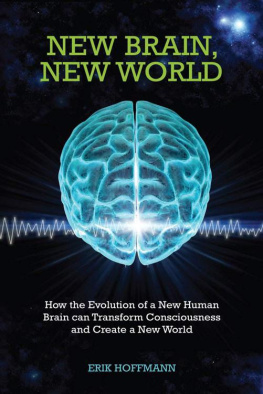Susan Greenfield
A DAY IN THE LIFE OF THE BRAIN
The Neuroscience of Consciousness from Dawn Till Dusk
PENGUIN BOOKS
UK | USA | Canada | Ireland | Australia
India | New Zealand | South Africa
Penguin Books is part of the Penguin Random House group of companies whose addresses can be found at global.penguinrandomhouse.com
First published by Allen Lane 2016
Published in Penguin Books 2017
Copyright Susan Greenfield, 2016
The moral right of the author has been asserted
Grateful acknowledgement is given for permission to reproduce or adapt the following:
Fig. 3 (Plate 3) from Chemical Society Reviews, 35, 897 (2006), reprinted with the permission of the Royal Society of Chemistry; Fig. 4 (Plate 4) modified from European Journal of Neuroscience, 32, 793 (2010), with the permission of John Wiley and Sons; Fig. 8 from Experimental Brain Research, 182, 495 (2007), reprinted with the permission of Springer; Fig. 9 modified from Progress inBrain Research, 150, 12 (2005), with the permission of Elsevier; table on p. 215 modified from Nature Reviews of Neuroscience, 5, 713, Box 2 (2004), with the permission of Nature Publishing Group.
ISBN: 978-0-141-97635-8
In memory of Reg Greenfield, 19152011
You cant use a knife of butter to cut butter.
Preface
My father always liked taking things apart and was fascinated by how anything and everything around him worked, be it his car, a TV, a jet engine or the body and the brain. Ever since I can remember, he would ponder in awe on the nature of electricity, human nature, belief and the precarious state of being alive, not with any fixed assumptions but revelling in the profundity and richness of the intellectual challenge of not having a simple solution. As James Thurber once remarked, It is better to know some of the questions than all of the answers, and I think this sheer enjoyment of savouring a problem and sharing it with others must have rubbed off on me very early: it certainly set me on the path for my choices at school. Science was taught as a series of known facts, and no room was left for further wonderment: the amoeba split in two; distilling water (of which no one explained the relevance) involved drawing with stencils a conglomeration of equipment involving conical flasks connected by ruler-sharp tubes and required neatness in the exercise book but not much else; the physics of time and space was encapsulated by ticker-tape trolleys spewing out white strips of paper with appropriately distanced dots stamped out on them. Despite the changes in education in the digital era, I suspect there is still room in science teaching to show students the more distant and less certain horizons to which the bread-and-butter rites of passage might lead. In my case, the big questions that trouble us all (but especially, perhaps, adolescents) as to why wars start, the nature of love, free will, destiny and, above all, the essence of ones own individuality seemed to be so much better met by history and literature in my case, of the ancient world. Accordingly, with great relief I abandoned science as soon as I could in favour of the old Victorian package of Latin, Greek, ancient history and maths.
The world of the ancient Greeks, in particular, offered the chance to explore what seemed to be the big questions about the human condition, and inevitably led into a more general interest in philosophy. However, in my first year at Oxford, I was brought up short by an emphasis on the seemingly forensic analysis of language: I can still recall sitting in the Bodleian Library one Saturday morning, ploughing through a whole chapter on the definite article (the) and reflecting that perhaps I had not, after all, made the best choice of subject. So it was that I changed to the then fledgling subject of psychology, grew increasingly to favour the more physiological options and became mesmerized, for the first time, by a science that didnt have simple answers but could address the very questions Id asked as a schoolgirl with empirically based discoveries. To everyones surprise, not least my own, I morphed into a neuroscientist, thanks to the huge support and encouragement of my then tutor Dr Jane Mellanby and the Head of Pharmacology, Professor William Paton. This was the start of a research career investigating novel brain mechanisms, with particular relevance to neurodegenerative disorders.
But that early fixation with the mind never left, and with it the nagging issue of consciousness: what it was and how it happened which perhaps amounts to one and the same question. Yet, if someone claimed to be able to answer that question, what would I have expected them to show me? A performing rat? A brain scan? A formula? Not even the most hypothetical and futuristic of scenarios could capture that essential or, rather, the quintessential ingredient: subjectivity. So, alongside the daily lab experiments, I carried on talking to philosophers, in particular, the late Susan Hurley. Together, we organized a wide-ranging series of debates between philosophers and neuroscientists that ended up being published in 1987 as Mindwaves. The appeal of these broad discussions, which often lasted long into the evening, was that I learnt how a topic common to both disciplines say, memory could clearly be approached with a completely different agenda, set of priorities and perspective. Above all, for me as a neuroscientist, the most important issue was the risk of neglecting the phenomenology the all-important subjectivity that caused one wag to label the neuroscientific exploration of consciousness as a CLM: a Career Limiting Move.
It was continuing reflections on the subjective nature of mind and consciousness that then led me, in 1995, to write Journey to the Centres of the Mind, and, in 2000, The Private Life of the Brain. Since you could lose your mind but still be conscious, it struck me that the two terms were far from synonymous and that working out how they related to each other, in neuroscientific terms, might offer a small step forward. The Private Life of the Brain, therefore, is mainly a theoretical foray, albeit based on a range of on empirical data, into how mind and consciousness could be rooted in the physical brain and how we might develop a system of studying these often interlinked but sometimes independent phenomena by correlating objective events with their respective subjectivity. I ended up concluding that we need some kind of Rosetta Stone, a frame of reference that is bilingual, something that could be described in phenomenological terms just as readily as in physiological ones.
The perfect candidate was not any macro-scale brain region, nor any micro-scale collection of synapses, but a mid-level, meso-scale brain process which, until the 1990s, had escaped detection: neuronal assemblies. Assemblies can be thought of as being a bit like the ripples generated by a stone thrown into a puddle: once triggered, large numbers (millions) of neurons generate a spread of activity, working together over a sub-second time frame. This fast scale of milliseconds had meant that assemblies were impossible to detect with classic brain imaging, which relies on indirect measurements, such as blood flow, and therefore typically has a resolution of only seconds. However, with the pioneering introduction of voltage-sensitive dyes which give a direct read-out of neuronal activity, it became possible at last to explore these highly transient coalitions of brain cells in real time.

